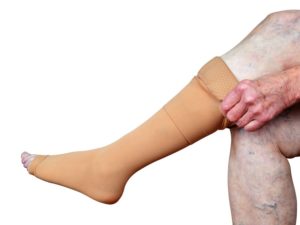Suffering from Leg Pain or Leg Swelling?
Do you suffer from leg pain?
Why do varicose veins hurt? When your legs ache, feel heavy and are getting swollen, it may be caused by vein disease. Much of the "vein pain" is caused by the pressure exerted by enlarged veins on the surrounding tissue. This pressure can be exacerbated by inflammatory agents your body releases in response, resulting in painful leg veins.
Varicose veins leg pain and venous insufficiency are caused when blood circulation, through the veins, is severely hampered, the vein's valves become weak and ineffective, thus allowing blood to pool in the lower legs. Think of filling a water balloon with water and the stress put on the balloon as more and more water enters the balloon. There is only so much room until the pressure becomes painful. You are not alone with leg vein pain, as venous insufficiency affects more than 30 million Americans. Chronic Venous Insufficiency occurs in forty percent of women and seventeen percent of men in the United States.
Oftentimes patients do not seek treatment for vein pain in the leg because they do not notice visible bulging veins, swollen varicose veins, or purple veins. People typically do not associate leg pain, or leg fatigue with a venous problem, when in fact, it is a very common cause of pain and an easily treatable ailment.
Get your free self-assessment checklist to gauge your varicose vein symptoms.
Patient Testimonial
"Just leaving the clinic and feel so confident with the results, can't wait until winter to do my additional treatment.
Thanks to Jilanne Rose for her time and friendly stuff.
Blessings"
Reyes Lopez
Advanced Vein Institute Patient
Leg Swelling
Leg swelling is often related to chronic venous insufficiency also known as venous reflux disease, a long-term problem with the veins not being able to pump blood back to your heart and blood stays in the leg. Swollen ankles are one of the most common symptom of chronic venous insufficiency. As leg and ankle swelling increases, the skin over your ankles may show red spots or a brownish tinge. The skin may also seem leathery or scaly, and may start to itch.
Inflammation plus venous reflux is a bad combination. Leg swelling and varicose veins swelling is a very bad thing in the lower extremities. Once leg swelling is present, healing is impaired and sometimes prevented. If swelling in the legs is not controlled, sores (ulcers) may begin occurring with the slightest trauma - a bump or scratch as the skin becomes very fragile, dermatitis, gout or an underlying inflammatory problem. Ulceration is defined as a breakdown of the skin caused by the chronic congestion in the venous system. When left untreated for long periods of time, recurrent cellulitis may also occur in the lower extremity which is painful and requires antibiotic therapy.
At Advanced Vein Institute, our vein experts often work with wound care centers and podiatrists to resolve non-healing ulcers and treat the swollen inflamed leg. In order to treat the swelling, we must treat the inflammation and ultimately, to gain permanent control, we get rid of the venous reflux with vein ablation, so it does not keep repeating itself.
Your Best Options for Varicose Vein Pain Relief
Reduce your risk of developing venous complications and find some relief for varicose vein pain by doing the following:
-
- Increase blood flow back to your heart by elevating your legs and wearing compression stockings. Read more about

- Increase blood flow back to your heart by elevating your legs and wearing compression stockings. Read more about
-
- Stimulate blood circulation and improve muscle power by exercising daily and losing excess weight to help control venous disease.
-
- If you have been diagnosed with chronic venous insufficiency, you may want to avoid intense aerobic activity such as running or cycling, as that may lead to increased fluid congestion, venous stasis, and exacerbate varicose veins.
-
- If your job requires you to stand or sit in place for a period of time, keep your blood moving by wiggling your toes, shifting your body position, and rising up on the balls of your feet.
-
- Stay hydrated! Drink plenty of water every day. To maintain basic body functions, the recommended daily water intake is a minimum of 54 ounces of water per day. However, this volume should be increased for persons who are active, or live in warmer or more humid climates. A lot of people find it difficult to drink water, but replacements like soda and sports drinks are full of sugar and can be more dehydrating than helpful. Try flavoring water with infusing it with fruits like oranges, mango, pineapple, or even cucumber.
-
- Dehydration does not cause varicose veins, however it can make your symptoms worse.
-
- If you smoke, start a cessation program. Read more on how smoking relates to varicose veins and spider veins.
-
- Be evaluated by a knowledgeable provider. The best way to understand your risk is to know where you are on the spectrum of the disease process.
-
 As difficult as it may be in the desert vascular experts recommend avoiding long-term sun and heat exposure of legs. Read more about why varicose veins are worse in summer heat
As difficult as it may be in the desert vascular experts recommend avoiding long-term sun and heat exposure of legs. Read more about why varicose veins are worse in summer heat
Learn more about what to do for varicose vein leg pain in varicose vein treatment options.
Not quite sure yet?
Why not read what other patients have said, we love to share feedback!

